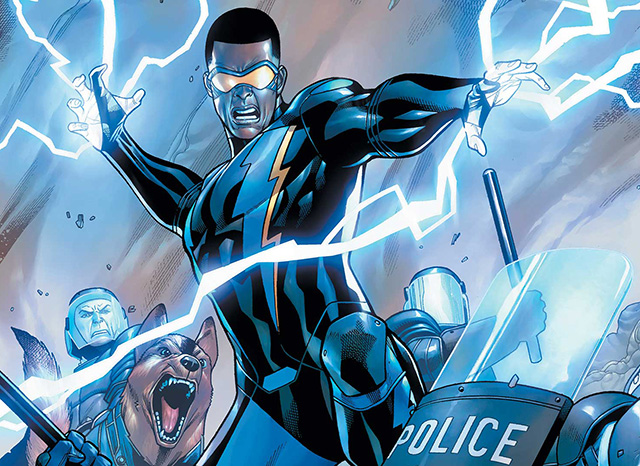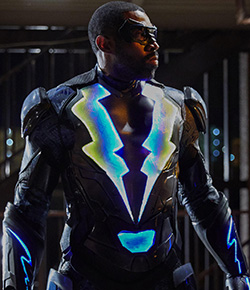Black Superhero History Series: Black Lightning

In honor of Black History Month I wanted to take some time to pay homage to some of favorite colored crusaders of justice. A few have been with me since my childhood, while others I became better acquainted with as an adult. I will be discussing heroes from both DC and Marvel, as they both have a very deep catalog of black superheroes to choose from.
In recognition of the debut of his CW series, I wanted to first discuss Black Lightning, DC’s first starring black character.
Debuting in April 1977 in Black Lightning #1, Black Lightning was conceived after a character called the Black Bomber, a white racist who would turn into a black superhero under stress, was deemed too controversial by the company.

Former Luke Cage writer Tony Isabella was asked to salvage the Black Bomber character. Isabella, who had been working the concept for Black Lightning’s character (civilian name Jefferson Pierce) on his own managed to convince editors to instead use his idea.
The character made a number of guest appearances in various titles over the next few years, including a string of issues of World’s Finest Comics, Detective Comics and a two-part story in Justice League of America in which the League invited him to join. In 1983, he regularly appeared again as a member of the Batman-led superhero team, the Outsiders. When that series ended, he returned to making occasional guest appearances.
It wasn’t until 1995 that Black Lightning was given a new solo series, with the art by Eddy Newell, and once again being written by Tony Isabella. However, it was cancelled after twelve issues, with Isabella (who was replaced after only five issues) stating that he believes the editor fired him because of a wish to bring in a new writer to “create his own power base at DC Comics.”
More than ten years later, a Black Lightning: Year One six-issue limited series, written by Jen Van Meter and illustrated by Cully Hamner, saw a bi-weekly release in 2009, and was nominated for two Glyph Awards in 2010.
As part of the New 52, a revamped version of Black Lightning appeared in DC Universe Presents where he was paired with the Blue Devil.
Black Lightning’s daughters inherited their father’s metahuman abilities. His eldest daughter Anissa, known as Thunder, can alter her density, rendering her almost indestructible and create shockwaves by stomping the ground. Pierce’s younger child Jennifer, also a superhero known as Lightning, has powers almost identical to her father though she is still inexperienced and not in full control of them.
Black Lightning continued to garner popularity in the comic world, with occasional appearances in other media, such as animated shorts showcasing him playing double duty as a superhero and as father.
Power set
Black Lightning’s powers include being able to shoot extremely powerful lightning bolts, strong enough to kill a man if he wanted to, but he usually uses the lightning to scare his enemies. When he does fire his lightning at people, he tries to stun if he can. In a pinch, he can also ionize the atmosphere, creating localized lightning storms which strikes hundreds of times per minute. He can also create quick charges of electricity in his fists to give his punches more of a shock.

Besides being able to control electricity, Black Lightning can turn into electricity himself. In his electrical form, Black Lightning is almost invulnerable. He can’t be hit with physical objects, can’t be poisoned or infected with any diseases, and he doesn’t need air, food or water to survive. He can go through conditions that would normally kill him, and even into space, as electricity, and survive. He can shoot himself across vast distances in electrical form, but also travel the same way regular electricity can; by jumping into electrical cables or wires, Black Lightning can move through the power system as fast as a spark can. In this form, Black Lightning can pass through walls or solid objects, and can move extremely fast. With his power over electricity, he can also make magnetic fields, allowing him to move and control objects.
Black Lightning also has a mystical ability to throw a different type of lightning that is colored black; it is fueled by his rage, and he grows stronger as he gets angrier.
With his electrical power, he can create huge walls or bubbles of energy, which can take punishment in his place. These force fields can be used to block incoming fists, bullets, and other physical attacks, including cars that try to run him over. The fields block energy blasts from weapons or other metahumans, and they can even block explosions, keeping him from being hit by grenades or bombs. He also has the ability to sense electrical fields around him, and can tell where electricity is coming from and how strong it is.
His powers allow him to absorb energy in order to make himself stronger. Black Lightning can then make himself stronger, faster, heal quicker and produce more lightning. Any source of electricity will do, but he has a fondness for absorbing lightning from thunderstorms. He can even drain power plants, which give him a huge boost, even if it does shut down power for the rest of the city sometimes. He can also use this power in an offensive way by draining energy from machines that might be attacking him.
As one of the most important black superheroes in geek culture, I hope you are able to learn a more about him, and will support the showrunners, artists and writers who continue to chronicle his adventures.
And look forward to the next Black Superhero History lesson.



